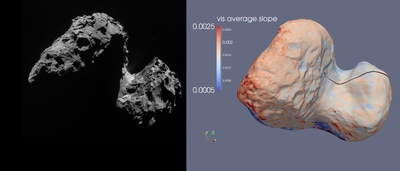Extremely dark, dry and rich in organics: VIRTIS view of 67P/C-G
The first surprising result emerging from VIRTIS’s study of Comet 67P/Churyumov-Gerasimenko is the measurement of its albedo, or how much sunlight is reflected by the surface of the nucleus. With an albedo of only 6%, about half as much as the Moon's, 67P/C-G is one of the darkest objects in the Solar System.
Such a low reflecting power indicates that the surface of the comet contains minerals such as, for example, iron sulfides, but also carbon-based compounds. The low albedo also indicates that there is little or no water ice on the outermost layers of the surface of the nucleus.
“This clearly doesn't mean that the comet is not rich in water, but only that there is no water ice in the outermost shell, just over one millimetre thick,” explains Fabrizio Capaccioni, VIRTIS Principal Investigator from INAF-IAPS in Rome, Italy. “The reason for this is rooted in the recent history of the comet's evolution, since repeated passes in the vicinity of the Sun cause surface ice to sublimate.”
Another interesting result based on these infrared observations concerns the discovery of macromolecular organic compounds over the entire surface of the comet's nucleus. Some of these compounds are similar to the carboxylic acids – or actually to polymers of carboxylic acids – that are present in amino acids.
While amino acids were already observed in cometary materials and in primordial meteorites, this is the first time that such compounds are directly observed on the surface of a comet nucleus. In addition, the global distribution of such compounds on the surface suggests that they were abundant in the material that assembled to build up the nucleus of the comet.
“The formation of such compounds requires the presence of ices of volatile molecules such as methanol, methane or carbon monoxide, which only freeze at very low temperatures,” explains Capaccioni. “Therefore, these compounds must have formed at large distances from the Sun, during the early stages of the build up of the Solar System. This suggests that we are facing a comet that locks up, in its interior, traces of primordial chemical compounds that date back to the formation of our Solar System, or possibly to an even earlier epoch.”
“The organic-rich surface of comet 67P/Churyumov-Gerasimenko as seen by VIRTIS/Rosetta” by F. Capaccioni et al. is published in the 23 January issue of the journal Science.
